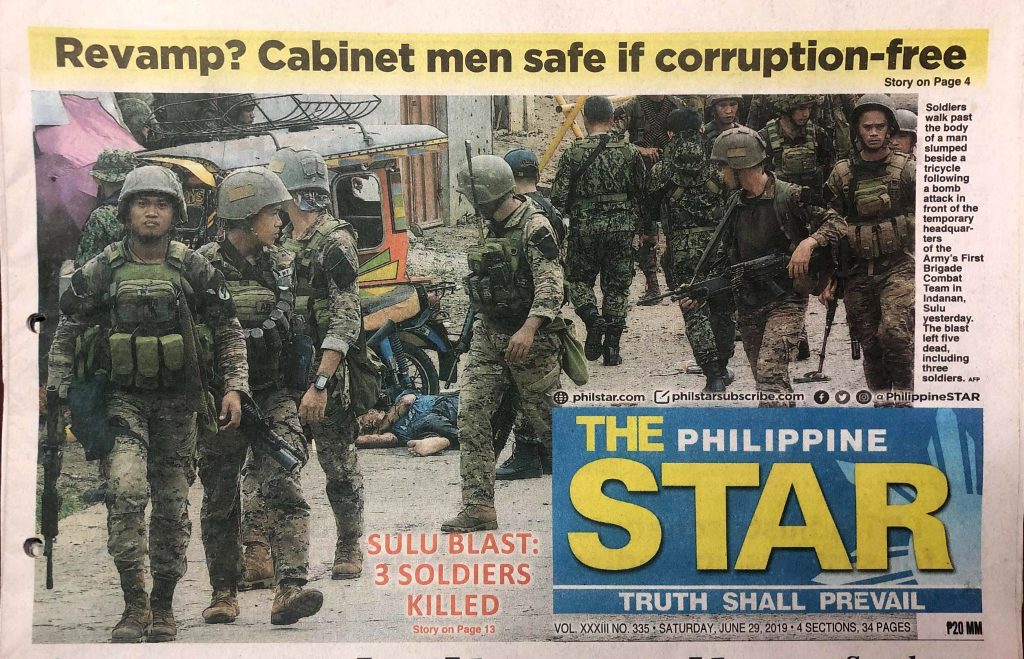Bomb Attack Underscores the Failure of Martial Law in Mindanao

MARTIAL LAW has been in effect in Mindanao since May 2017. And yet the region has continued to suffer from bomb attacks. So far, there have been at least 7 bombing incidents reported during the period; the latest on June 28.
Two explosions rocked the camp of the 1st Brigade Combat Team of the Armed Forces of the Philippines (AFP) in Indanan, Sulu, killing eight people and injuring 22 others. Outpost guards accosted a man who was acting suspiciously and discovered he was carrying explosives, which exploded while the suspect was being held. The second bomb went off soon after another suspect was shot as he was rushing through the gate damaged by the first detonation.
Defense Secretary Delfin Lorenzana said the Indanan attack was the third of its kind, an “occurrence” causing much concern. Lorenzana was referring to the bombing incidents involving a van-bomb in Lamitan, Basilan and the twin blasts that hit the Our Lady of Mount Carmel Cathedral in Jolo, Sulu in July 2018 and in January 2019 respectively. None of the reports provided the context of the martial law regime which has been in effect in Mindanao for two years. None of the reporters asked military sources why security forces have not been able to prevent such bombings.
CMFR monitored reports from the three main Manila broadsheets (Manila Bulletin, Philippine Daily Inquirer and The Philippine Star), primetime newscasts (ABS-CBN 2’s TV Patrol, CNN Philippines’ News Night, GMA-7’s 24 Oras and TV5’s Aksyon), as well as selected online news websites from June 28 to July 3, 2019.
Reporting the Attack
Using AFP sources, initial media reports described how the incident happened and who were responsible. They noted the military’s careful comments on whether the attack was indeed a case of suicide-bombing, a tactic which security officials had long said goes against local culture, although the AFP said it is not discounting the possibility that the bombs were remotely detonated by another person.
Military officials pointed to the Abu Sayyaf Group (ASG) as the culprits, but media reports also noted that the Islamic State (IS) has claimed responsibility for the attack. The coverage was careful enough not to fan the supposed IS connection, since the AFP also cautioned against “jumping to conclusions”. An Inquirer report recalled that IS often claims responsibility for “almost any attacks, even insignificant ones” to keep its name in the news.
Later reports focused on the identity of one of the bombers, who was found to be a Sulu native and a member of the ASG. The second bomber, reports noted, was suspected by the military of being the son of the Moroccan bomber who was involved in the van-bomb explosion in Basilan in 2018.
Violence Despite Martial Law
The government has insisted that martial law is necessary to address the peace and order situation in Mindanao. But the latest bombing incident indicates that martial law has not succeeded in its purpose. Media coverage shows that reporters have not called attention to this failure, nor have they analyzed why even with martial law, government has been unable to deter violence and protect communities.
The attack on a military outpost suggests how ineffective martial law has been in addressing terrorism in Mindanao. The point should have been highlighted, with journalists asking the military to explain the situation or government officials to justify the continuation of martial law. Media should have provided this context in the coverage, but did not.
Leave a Reply